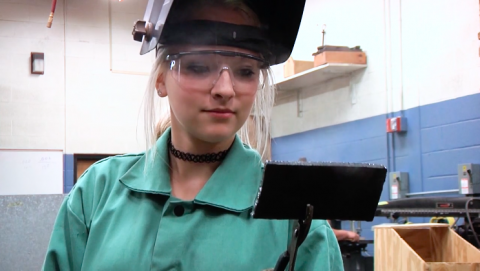After decades of pushing bachelor’s degrees, U.S. needs more tradespeople
FONTANA, Calif. — At a steel factory dwarfed by the adjacent Auto Club Speedway, Fernando Esparza is working toward his next promotion.
Esparza is a 46-year-old mechanic for Evolution Fresh, a subsidiary of Starbucks that makes juices and smoothies. He’s taking a class in industrial computing taught by a community college at a local manufacturing plant in the hope it will bump up his wages.
It’s a pretty safe bet. The skills being taught here are in high demand. That’s in part because so much effort has been put into encouraging high school graduates to go to college for academic degrees rather than for training in industrial and other trades that many fields like his face worker shortages.
Now California is spending $6 million on a campaign to revive the reputation of vocational education, and $200 million to improve the delivery of it.
“It’s a cultural rebuild,” said Randy Emery, a welding instructor at the College of the Sequoias in California’s Central Valley.
Standing in a cavernous teaching lab full of industrial equipment on the college’s Tulare campus, Emery said the decades-long national push for high school graduates to get bachelor’s degrees left vocational programs with an image problem, and the nation’s factories with far fewer skilled workers than needed.
“I’m a survivor of that teardown mode of the ’70s and ’80s, that college-for-all thing,” he said.
This has had the unintended consequence of helping flatten out or steadily erode the share of students taking vocational courses. In California’s community colleges, for instance, it’s dropped to 28 percent from 31 percent since 2000, contributing to a shortage of trained workers with more than a high school diploma but less than a bachelor’s degree.
Research by the state’s 114-campus community college system showed that families and employers alike didn’t know of the existence or value of vocational programs and the certifications they confer, many of which can add tens of thousands of dollars per year to a graduate’s income.
“We needed to do a better job getting the word out,” said Van Ton-Quinlivan, the system’s vice chancellor for workforce and economic development.
High schools and colleges have struggled for decades to attract students to job-oriented classes ranging from welding to nursing. They’ve tried cosmetic changes, such as rebranding “vocational” courses as “career and technical education,” but students and their families have yet to buy in, said Andrew Hanson, a senior research analyst with Georgetown University’s Center on Education and the Workforce.
Federal figures show that only 8 percent of undergraduates are enrolled in certificate programs, which tend to be vocationally oriented.
Sen. Marco Rubio, R-Fla., last year focused attention on the vocational vs. academic debate by contending during his presidential campaign that “welders make more money than philosophers.”
The United States has 30 million jobs that pay an average of $55,000 per year and don’t require a bachelor’s degree, according to the Georgetown center. People with career and technical educations are actually slightly more likely to be employed than their counterparts with academic credentials, the U.S. Department of Education reports, and significantly more likely to be working in their fields of study.
...




